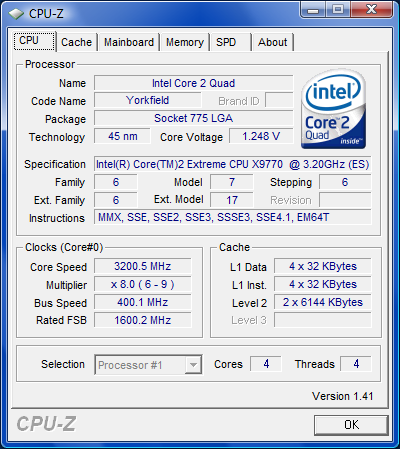Intel Core 2 Extreme QX9770: Paper Tiger?
Paper Tiger Against AMD
Only three weeks ago, Intel unveiled its 45 nm fabrication technology in the shape of the Penryn processor. However, the only model available at launch was the Extreme Edition model QX9650. Compare Prices on Core 2 Extreme QX9650 Since the Extreme Edition models have always come in at just under $1,470, the energy efficient 45 nm technology will remain out of reach for most users. In other words, for now there will be no revolution in the mass market.
As we were gearing up to cover the launch of AMD's highly anticipated Phenom quad-core processor, we received an email with the following information (our paraphrase).
Intel is planning to unveil a new 45 nm processor with the designation Core 2 Extreme QX9770. This new part will become available in the first quarter of 2008. Furthermore, Intel informed us that we should simulate this new CPU using the QX9650 in or lab, as it wouldn't be distributing any review samples, since none exist yet.
This is the first time in recent memory that Intel is introducing a new processor without having a concrete model at hand. Our obvious conclusion - Intel is worried about AMD's Phenom launch and is trying to steal the limelight.
Looking back at the introduction of AMD's first Athlon 64 processor, we can understand Intel's anxiety. At the time, Intel's Netburst architecture was no match for the young and fresh Athlon 64. Back then, the processor heavyweight followed the same strategy, pulling the Pentium 4 Extreme Edition out of its hat at the last minute before AMD's launch. This part was based on the Northwood core, featured 3 MB of L2 cache, and was basically a repackaged and rebranded Xeon processor.
The new Extreme Edition QX9770 runs on a 400 MHz FSB (1600QDR) and uses an 8x multiplier, resulting in a clock speed of 3.20 GHz. Thus, Intel's big announcement is basically that it is raising the frequency of its high end CPU by 200 MHz.
This is what a Core 2 Extreme QX9770 could look like come 2008.
Since there is currently no chipset in the market that (officially) supports FSB1600, Intel suggests using a current X38 motherboard and overclocking the FSB manually. This is both strange and remarkable. After all, Intel has always been a great advocate of using its products within their specifications, putting stability first. What could have motivated this sudden change in attitude, we wonder?
Get Tom's Hardware's best news and in-depth reviews, straight to your inbox.
Tom's Hardware is the leading destination for hardcore computer enthusiasts. We cover everything from processors to 3D printers, single-board computers, SSDs and high-end gaming rigs, empowering readers to make the most of the tech they love, keep up on the latest developments and buy the right gear. Our staff has more than 100 years of combined experience covering news, solving tech problems and reviewing components and systems.
-
Capitannimo I am not sure why you are not mentioning the cooling system you use.Reply
Also why you don't mention that this processor needs water cooling system even if not over clocked. -
Intelextreme Looks like a Zalman fan to me in the pictures so maybe water cooling is not needed, at least for those not into cases (something I typically consider "benchmark machines" and was surprised by the lack of dry ice. By the way thermoelectric, chilled water, cooling using peltiers can't be beat! Finally I have a QX6850 and I get a 3mdMark06 of 18,548 with a Gigabyte EX38-DQ6 and a Shappire Radeon HD4870 X2 2gb (using not yet anywhere near perfected drivers) and without overclocking the GPUs until a water block is released for it. I was going to upgrade to a QX9770 now that I can pick one up for a good price since the 9775 came out but since reading that the difference in speed is not incredible I have decided to wait for the new Core i7 or whatever they call the new extreme processor and motherboards with new sockets coming out soon.Reply -
Intelextreme To show the QX9770 overclocked alone is bias as I run my QX6850 overclocked. When compared to the QX9770 running at stock speed, the QX6850 differs typically by a few points, it is not until the QX9770 is overclocked to 4ghz that the difference becomes as high as close to 20% in come cases. However, that ignores the fact that a lot of the other processors are good overclockers, and I can overclock my QX6850, using thermoelectric chilled water cooling, to a stable 3.8. Therefore, the difference between the two in terms of speed is not enough at this point to justify purchasing an X48 chipset motherboard and a QX9770 when a new socket and extreme CPU is coming out soon. If I was putting together a computer now I would likely go cheap and look for a used QX6800 and as good a used motherboard as possible just because I would be selling them soon anyway.Reply


